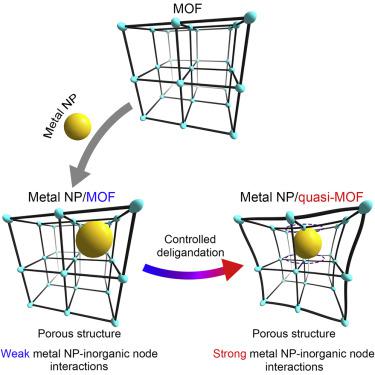Chem ( IF 19.1 ) Pub Date : 2018-04-05 , DOI: 10.1016/j.chempr.2018.03.009 Nobuko Tsumori , Liyu Chen , Qiuju Wang , Qi-Long Zhu , Mitsunori Kitta , Qiang Xu

|
Metal-organic frameworks (MOFs) are excellent supports for metal nanoparticles (NPs), but the interactions between metal NPs and inorganic nodes of MOFs are weak because of the presence of organic ligands. Here, we present a strategy for strengthening the metal-NP/MOF interactions through controlled deligandation of the metal/MOF composites by thermal transformation. The controlled deligandation of MOF results in the formation of a “quasi-MOF,” which has a transition-state structure between the porous MOF and metal oxide. The obtained metal/quasi-MOF composites not only retain a porous structure but also achieve a strong interaction between the metal NPs (i.e., Au) and the inorganic nodes (i.e., Cr–O) of the quasi-MOF, leading to dramatically enhanced catalytic performance in the low-temperature oxidation of carbon monoxide (CO). The present findings could open new avenues for the design of superior heterogeneous catalysts.
中文翻译:

准MOF:将无机节点暴露于客体金属纳米颗粒以显着增强催化活性
金属有机骨架(MOF)是金属纳米颗粒(NP)的极佳载体,但由于有机配体的存在,金属NP与MOF无机节点之间的相互作用较弱。在这里,我们提出了一种通过热转化控制金属/ MOF复合材料的去配位来增强金属-NP / MOF相互作用的策略。MOF的受控脱配导致形成“准MOF”,该准MOF在多孔MOF和金属氧化物之间具有过渡态结构。所获得的金属/准MOF复合材料不仅保留了多孔结构,而且在准NPF的金属NPs(即Au)和无机节点(即Cr-O)之间实现了强大的相互作用,从而显着增强了一氧化碳(CO)的低温氧化中的催化性能。











































 京公网安备 11010802027423号
京公网安备 11010802027423号